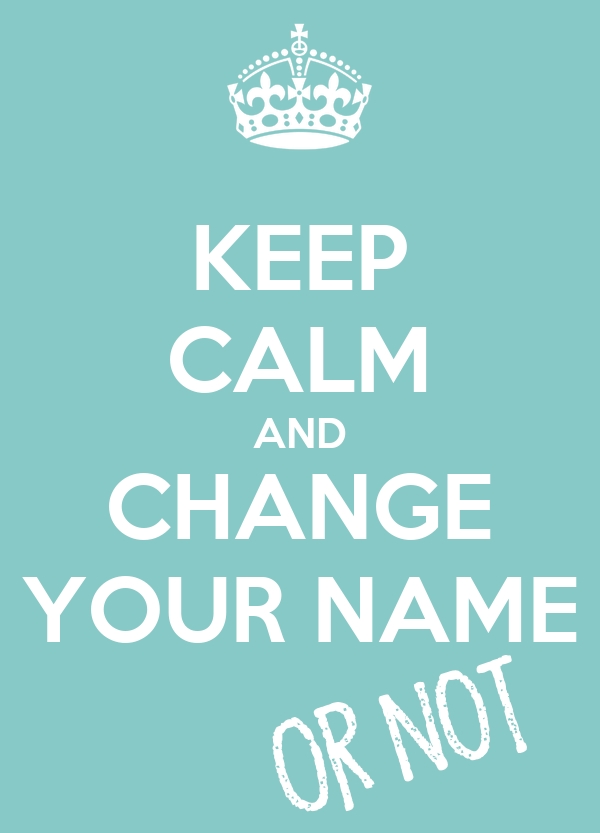Changing Your Name - Legal or by Marriage?
Categories: | Changing Your Name | Wedding Legals |
 One of the more frequently asked
questions in relation to getting married is about
changing your name. What makes it tricky is that
One of the more frequently asked
questions in relation to getting married is about
changing your name. What makes it tricky is that- There is still a widespread belief that, on marriage, women must (or at the very least should) change their name to that of their husband (not true).
- There are two different ways to change your name, and you will be given conflicting advice about which one applies to you
So, if you've ever wondered whether you are legally required to change your name on marriage, or even why we say Mr and Mrs and never the other way round, or even why Princess Michael of Kent is called by her husband's first name and not her own (it is Marie Christine Anna Agnes Hedwig Ida von Reibnitz) here are the facts.
Names and the law in
Australia
If you are a woman, it has been accepted (and expected) forever that when you get married you will take on your husband's name (change of name by marriage). It is now widely accepted that anyone getting married, regardless of gender, can
- keep their birth name, or
- take on their spouse's surname, or
- hyphenate their last names in either order, with or with the hyphen between the names.
The history of the custom
for women to change their name
Up until that time, surnames hadn't really been necessary or set in stone. We still see the evidence of the practice at the time of identifying individuals by a nickname, often describing some personal characteristic, their occupation or some geographical reference in many surnames today. Names such as Carpenter and Wright, Little and Small, and Paddock and Hill.
Norman feudal law erased a woman's identity on marriage through the Law of Coverture, a term that refers to the fact that, on marriage, a woman was "covered" by her husband's identity. The two became one. The one being the husband. So legally she was subsumed into the husband's legal identity and from the date of their marriage they were treated as one entity. In essence, her separate legal existence disappeared as far as property rights and certain other rights were concerned. And thus, she was required to take on her husband's surname.
None of that applies in Australia any more. So changing your name is optional, and, this bears repeating, either of you can assume your spouse's surname.
Changing your name after
marriage
- You can change your name by marriage, or
- You can apply for a legal change of name.
Three important things
to know
- Regardless of whether you are an opposite sex couple, a same sex couple, or one or both of you is non-binary, the full range of options of how you change your name after marriage is available to both of you.
- There is no time deadline - you can decide whether or not to change your name at your leisure. (NB In Australia that is. In some US states, for example, the decision has to be made before marriage as it is noted on the marriage licence.)
- You can reclaim your birth name at any time. If
you change your name by marriage (see below for
how that differs from a legal name change), you
don't have to get a divorce if you change your
mind and want to go back to your original name.
A traditional "change of
name by marriage"
It is not a legal requirement to change your name on any documentation. Nor is it a legal requirement to stop using your maiden (birth) name entirely. A growing number of women chose to use their married name socially but keep their maiden (birth) name for professional purposes and use (and to keep being searchable on Google and on social media). It is perfectly legal to keep your maiden name on official ID documents. The important thing is to be consistent about where and when you use each name. Government and financial institutions are inclined to get a bit awkward if you present inconsistent documentation.
If you decide to change your name on your documentation, the process is straightforward:
- You have to have been married in Australia.
While your overseas marriage will be
recognised in Australia, because it is not
registered in Australia change of name by
marriage isn't available to you. You
will have to apply for a legal name change.
- You need to have a copy of your official marriage certificate (the one you apply for to Births, Deaths, and Marriages in the State or Territory in which you got married). This certificate proves that your marriage was registered
- And then you take that certificate, together
with your birth certificate to prove the link
between the two names, plus whatever it is
that you are asking to be reissued to the
various entities where you want to change your
name and ask for that to be done.
Hint: Start with photo ID such as driver licence or passport, because that can then be used to do things like change your name online on the electoral role
Cost: There is no cost to have your documents reissued in your new name. Not even for your new passport, though that does have some conditions - you must have at least 2 years validity left on your passport and you must apply within 12 months of getting married.
Your choices
And that's still one of the choices. A common
alternative is that the wife hyphenates her
birth name with her husband's surname. And he
changes nothing.
But there are other choices, choices that apply to either and both of you, regardless of gender.
- One of you can change your surname to that
of the other, so you both have the same
surname - typically Mr and Mrs Jones,
for example (or Mr and Mr Jones or Mrs
and Mrs Jones)
- One of you can hyphenate your birth surname
with that of the other, so one of you retains
your birth name within your married name, and
the other one doesn't change their name -
typically Mr Jones and Mrs
Smith-Jones
- Both of you can combine your names, with or without a hyphen, in either order, Smith-Jones, Smith Jones, Jones-Smith, or Jones Smith.
- One of you can use your "married name" socially but keep using your birth name professionally. This is still almost exclusively a choice made by professional women.
- Both of you can decide NOT to change your name.
- Or both of you can choose a whole new
surname (this requires a legal name change)
Legal name change
Other things about a formal legal change of name that you need to be aware of:
- This form of name changes obliterates your birth surname and retrospectively changes your surname on your Australian birth certificate. You will be issued with an amended birth certificate.
- If you were born overseas, you will be
issued with a change of name certificate
- There are residence conditions. If you were
not born in Australia you need to be a
permanent resident who has lived in your
current state for the previous 12 months. If
you were born in Australia you apply to BDM in
the state or territory in which you were born
- There are limits on how often you can change
your name and how many times in your lifetime
you can do so. In Queensland, for example, you
can only change your name once in a 12 month
period. In New South Wales and Victoria, for
example, you can only change your name three
times in your lifetime. Other states have
similar rules.
- You need to apply for a legal name change, pay a fee, and provide a long list of documentation
- You don't have to have gotten married in
order to change your name legally
- It can take quite a long time - months - from application to approval.
Do you always have to
show your official marriage certificate?
Some organisations may accept the Presentation Certificate (the pretty one you were handed on the day, officially Form 15) because it is proof that the marriage took place, and it doesn't include any personal information other than your full names. Sad but true, using the Presentation Certificate will be straightforward if you are a wife doing a straight swap to her husband's surname. For anything else, you may have to deal with skepticism. At which point, your updated driver license or adult proof of age card should settle the argument.
Your doctor, dentist, or other medical practice should accept your updated medicare card as evidence, a good reason to change that once you get your new photo ID (driver licence, passport, or adult proof of age card).
Any place where it is just a matter of them changing your name on their membership list should accept your word for it.
Going Facebook Official doesn't require any proof, and nor does changing your name on Facebook
What if you get
divorced, separate, or just change your mind?
If you wish to continue to use your "married" name, you are free to do that. Your ex can't stop you using the name.
If you have gone through a legal change of name, you have to make a new application, abiding by all the rules for that, so the process is much more protracted.
Something you might
not have thought of
Related Information
